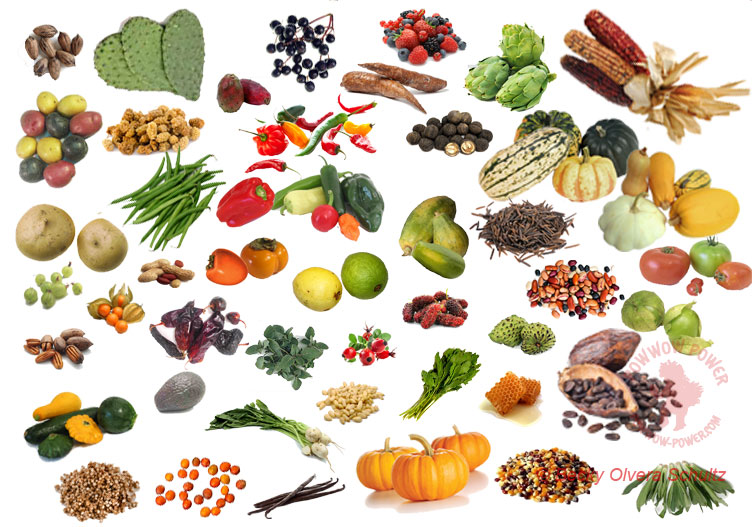Indigenous Foods
Foods Indigenous to the Americas
Over 55% of the foods we enjoy today are indigenous to the Americas. Many Native American peoples refer to three staples as the Three Sisters–beans, squash and corn (maize) which are considered the basis of many indigenous diets. This trio is usually grown together; beans can grow up the corn stalks, adding nutrients to the soil and the squash is planted between them to help keep the weeds out. These three foods originally came from the part of the Americas that is now called Mexico, Central and South American. These foods eventually made their way to North America.
The Americas are abundant with a large variety of food plants. Many people think potatoes come from Ireland but they are indigenous to the Americas and originally came from South America. There is debate as to whether the origin was Peru or Chile but there is evidence that potatoes were domesticated as far back as 10,000 years in the high Andes of Peru and Bolivia. There are more than 3,800 varieties of potatoes in Peru alone.
The indigenous peoples of the Americas hunted and fished when possible. Both fresh water fish and ocean fish were an important part of the diet to those tribes with access to lakes, rivers and the ocean. Hunting and trapping animals for meat was important and when abundant, the excess was smoked or dried.
Pemmican was made by some northern tribes. This was made of a lean dried meat that was crushed to a powder and mixed with a melted animal fat. Sometimes crushed berries were added. It was stored in rawhide bags. Pemmican kept well and was nutritious with high protein and healthy fat, especially when other foods were scare.
Although a large variety of mushrooms are abundant in the Americans, native peoples rarely used mushrooms as food source but rather for medicinal, ceremonial and spiritual reasons.
In addition to a wide variety of fish, some of the animals hunted or trapped for food were and may still be are antelope, badger, bear, beaver, bighorn sheep, bison, deer, dove, duck, elk, geese, ground hog, grouse, guinea pig, moose, opossum, otter, prairie chicken, prairie dog, quail, rabbit, turkey and turtle, to name a few.
A Word About Fry Bread: Fry bread has been a contemporary “Indian” food for some years now and a regular item served at native gatherings and powwows, but it is not an indigenous food. The story of how it came to be varies. Although associated with Native Americans and called “Indian Fry Bread” or “Indian Tacos” or “Navajo Fry Bread”, it is far from an indigenous food. It is primarily made from flour and deep fried. Wheat flour is not indigenous to the Americas and deep frying was not something native peoples did. Fry bread is blamed for contributing to high levels of diabetes and obesity among native peoples since it is high in calories and fat. It’s interesting that Native Americans would embrace a food that is not natural to their diet and represents the brutality of the past when flour was given as a ration. Enjoy fry bread, but in moderation!
The variety of indigenous plant based foods in the Americas is extensive. This list is not complete but shows a good amount of foods either gathered or farmed in the Americas over the years:
- Achiote (Annatto Seed)
- Acorn
- Acuyo
- Agarita Berries
- Agave Nectar
- Allspice
- Amaranth
- American Chestnut
- Amole Stalks
- Arrowroot
- Artichoke
- Aspen Inner Bark & Sap
- Avocado
- Barbados Cherry (Acerola)
- Beans
- Bear Grass Stalks
- Birch Syrup
- Black Walnuts
- Blackberries
- Blueberries
- Box Elder
- Cacao (Chocolate)
- Cactus Fruits
- Camas
- Canella Winterana (White Cinnamon)
- Cashews
- Cassava
- Cattail Rootstalks
- Celery
- Century Plant (Mescal or Agave) Crowns & Shoots
- Cherimoyas
- Cherries
- Chicle (Gum)
- Chili Peppers (Includes Bell)
- Chokecherries
- Cholla Fruit
- Corn (Maize)
- Cranberries
- Cucumber
- Culantro
- Currants
- Custard Apple
- Datil Fruit & Flowers
- Devil’s Claw
- Dropsee Grasses
- Elderberries
- Emery Oak Acorns
- Epazote
- Garlic
- Goldenberries
- Gooseberries
- Grapes
- Guarana
- Guava
- Hackberries
- Hawhtorne Fruit
- Herba Luisa Hueinacaztli (Ear Flower)
- Hickory Nuts
- Honey
- Horsemint
- Huckleberries
- Jicama
- Juniper berries
- Kaniwa
- Kiwacha
- Knotweed
- Lamb’s Quarters Leaves & Seeds
- Lepacho
- Leren
- Little Barley
- Locust Blossums & Pods
- Lucuma
- Maca
- Mamey
- Manioc (cassava)
- Maple Syrup
- Mashua
- Maygrass
- Melons
- Mesquite Bean Pods
- Mexican Anise
- Mexican Oregano
- Mint
- Mulberries
- Nopales
- Oca
- Onion or Meadow Garlic
- Palmetto
- Papayas
- Passionfruit
- Pawpawspi
- Peanuts
- Pecans
- Persimmon
- Pigweed Seeds
- Pimento
- Pine Nuts
- Pineapples
- Potatoes
- Prairie Turnip or Breadrootarti
- Prickly Pears
- Pumpkins
- Purslane Leaves
- Quinoa
- Ramps (Onions)
- Raspberries
- Rose Hips
- Sage
- Saguaro
- Salt
- Sangre de Drago
- Sapote
- Sassafras
- Screwbean Fruit
- Sea Grape
- Sedge Tubers
- Shagbark Hickory
- Shepherd’s Purse Leaves
- Sotol Crowns
- Soursops
- Spanish Bayonet Fruit
- Spanish Lime (Mamoncillo)
- Squashes



